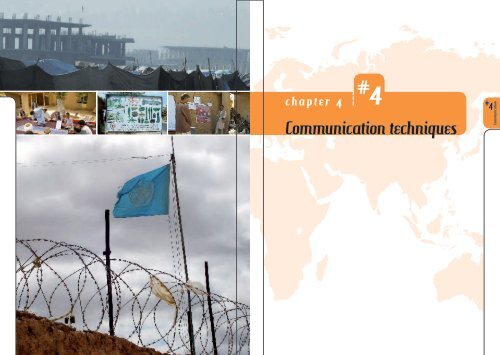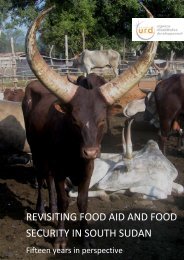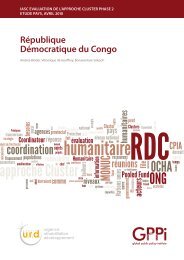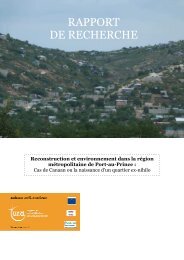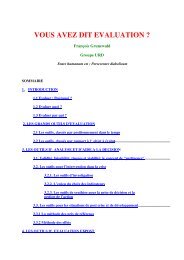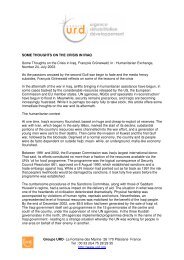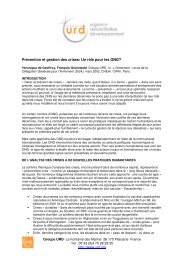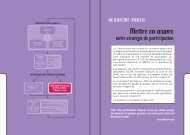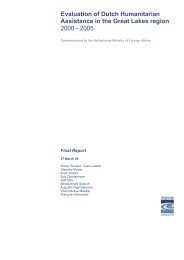Chapter 4 - Groupe URD
Chapter 4 - Groupe URD
Chapter 4 - Groupe URD
Create successful ePaper yourself
Turn your PDF publications into a flip-book with our unique Google optimized e-Paper software.
chapter 4#4Communication techniques#4Communication
Participation Ha n d b o o k fo r hu m a n i t a r i a n fi e l d wo r k e r sInv o l v i n g crisis-af f e c t e d pe o p l e in a hu m a n i t a r i a n re s p o n s eCo m m u n i c a t i o n te c h n i q u e s102Effective communication is the fundamental building blockof participation, and central to designing a strategy for participation.This chapter looks at formal and informal ways ofcommunicating with crisis-affected people. Formal communicationtakes place through meetings, focus group discussionsand so on, whilst informal communication is more opportunistic,for example simply chatting to people whilst you walkthrough a community. There are advantages and disadvantagesto both types of communication: informal communicationis often anecdotal and therefore can be biased, but is alsoless constrained and people are much more likely to saywhat they really think. However, it is easier to control communicationin more formal settings. Both aid agencies andcommunities are more accountable for what they say duringmeetings when an official record is often kept. It isn’t necessaryto choose between one and the other – both should bepart of your strategy.The way in which you communicate – your attitude and behaviour– is as important as the method you choose, and isthe key to successful participation. Your origin, status, gender,age, profession, experience or knowledge of the areaall affect how you are perceived. See chapter 3 on buildingmutual respect.IV.1 InformalcommunicationIt is important to take the time to speakinformally with people. Opportunitiesto engage with people on a casual orinformal basis are often missed, yetthey constitute a rich source of exchange, which can complementformal events like focus groups and communityassemblies. They are opportunities to gather information,to increase your understanding of the community and to bebetter accepted – in fact you may be thought “standoffish”if you fail to take up these opportunities.There are many situations that offer the opportunity forinformal communication:• stopping at the bar or tea house• going to the market and speaking with peoplein the street, or even just being seenthere• going to the bath house or washing point– both useful places for female aid workersto talk to women and girls• attending public events, such as religiousceremonies and village gatherings• taking advantage of minor incidents: fixing aflat tyre or repairing a car, for instance, canlead to an informal gathering• speaking with the driver and with cooks orwaiters/waitresses in restaurants• stopping by the road and talking with farmers in fields orwith herders at water points.Formal communication with communitiesgives an opportunity for leadersand spokespeople to present information,policy or opinions to the aidagency. Often the people you communicatewith on a formal basis willhave some official position or status within their community(village leader, government official, head of a women’sgroup) or will be part of a formal structure of some sortsuch as the camp management team or the village council.Much of this section is about formal communication, buta great deal of it is also relevant to informal and casualcommunication methods.Formal means of communication include:• structured interviews• focus groups• traditional assembliesIn many situations, ifyou start to conversewith one or twopeople, you will findthat others join in,and that a ‘focusgroup’ will takeshape spontaneously.In a humanitariancrisis social dynamicschange so look fornew opportunities tocommunicate withdifferent groups.Tips & WarningsIV.2 Formalcommunicationmethods103#4Communication
Participation Ha n d b o o k fo r hu m a n i t a r i a n fi e l d wo r k e r sInv o l v i n g crisis-af f e c t e d pe o p l e in a hu m a n i t a r i a n re s p o n s eCo m m u n i c a t i o n te c h n i q u e s104crises, new leadersmay emerge. Whendealing with formalrepresentatives ofa population, try tofind out how theygained their positionand the basis of theirauthority. Were theydemocratically electedor self-selected? Havethey discussed theissue at hand with thepeople they intend torepresent?Tips & WarningsIn humanitarian• organised discussions with targeted audiences likewomen’s groups and childrenYou can consider using many differenttypes of ‘meetings’ as part of your participationstrategy including focus groups,large assemblies and smaller meetings orinterviews. Whether formal or casual, allopportunities to exchange with people shouldbe taken seriously. They are a means of gaininginformation, developing understandingand building mutual respect and they allowpeople to both influence you and hold you toaccount.Planning meetings with groupsThere are already many resources for guidanceon facilitating meetings, running focusgroups and using techniques such as participatoryrural appraisal or participatorylearning in action. The aim of this handbook is not to repeatprior information, but to underline the main elements relevantto participation in humanitarian situations. Additionalresources can be found in Part 3.Although each meeting, interview, or event will differ interms of objectives and participants, a number of basicprinciples and general guidelines should be followed:Deciding on the purpose of the exerciseWhat do you want to achieve and how will you ensure realmutual communication between you and the people you talkto, rather than just extraction of information? In order todecide how you will communicate with different individualsand groups, it is useful to discuss this in advance with thoseconcerned.Gathering background informationIn order to prepare for a group session you will need tocollect some background information about the situationvia key informants, observation and informal discussion. Itis important to understand the security situation and thepotential risks to your team and theparticipants, to be aware of localsocial dynamics to avoid excludingor marginalising individuals orgroups of people and to be informedabout any political issues thatmight cast doubt on your independence,neutrality and impartiality.In humanitarian crises the situationcan change very quickly - be preparedto update your knowledge on aregular basis.In large, formal group sessionsindividual participation isdetermined by power relationswithin the group. Sociallymarginalized people such asethnic minorities, disabledpeople or women may notfeel they can contribute freely.By planning other smallerevents or meetings you canprovide these groups with anenvironment where they feelmore comfortable expressingthemselves.Planning events with the communityPreparation is important for agroup session such as a communityassembly. Knowing in advancewhat methods you are going to use,where the event will take place andwho the participants will be willhelp you to achieve your objectivesfor the meeting. Preparation caninclude a preliminary field visit toa possible venue and discussion ofthe purpose of the exercise, how it will be carried out andwho should attend.Ask some of your key contactsfor advice on how formal themeeting should be and anyother cultural tips. Dress andbehave as is necessary tobe taken seriously and showrespect to the participants.Keeping a recordWhatever your purpose or method, you are likely to want totake notes to help you remember what was said and to ensureaccuracy later on. It is important to explain why you are doingthis. Some people may be suspicious about what later usewill be made of the notes, especially if they are concernedabout their personal security. Avoid such worries by explaininghow the notes will be stored, and how you will ensureconfidentiality, for example, by not using real names or otherinformation that might be used to identify individuals.Their time…Time is a precious resource, especially when people are strugglingto survive. By informing people of what you are doing,Tips & WarningsTips105#4Communication
Participation Ha n d b o o k fo r hu m a n i t a r i a n fi e l d wo r k e r sInv o l v i n g crisis-af f e c t e d pe o p l e in a hu m a n i t a r i a n re s p o n s eCo m m u n i c a t i o n te c h n i q u e sExample106and why, they can decide whether meeting with you is a priority.People affected by crises have needs that they hope youmay be able to meet, and may be impatient of long drawn outprocesses for relatively simple and obvious matters.Consider whether you can carry out joint exercises withother agencies to reduce the time-burden on the populationand to make sure that they are not subjected to a stream ofmeetings and consultations.Make sure that you don’t plan meetings at inappropriate timessuch as during prayer hours, and think about who might beexcluded at different times of the day because of their otherobligations.…and your timeParticipatory processes seem time-consuming in the initialstages, when a speedy response to urgent needs is called for.However relationships built at the beginning can make thehumanitarian response more effective and accountable. Evenfairly limited involvement of affectedpeople at this stage is useful in buildinglater participatory approaches.An aid organisation wishedto conduct a focus group ina Guinean village, and hadagreed on a meeting time withthe village elders. When theteam arrived, somebody haddied in the village, and thefuneral was to take place atthe same time as the meeting.Elders started dividing theparticipants who were presentbetween those who wouldattend the funeral and thosewho would attend the meeting.But the aid worker proposed topostpone the meeting to enableall the villagers to attend thefuneral. Grateful for the team’sconsideration and respect,the whole village held anassembly to meet with the aidorganisation after the funeral.Try to strike a reasonable compromisebetween your need to respond to thecrisis and respect for the participants’rhythm. Without losing sight of the needto achieve results in terms of meetingtheir needs, try not to pressure theminto making decisions.As humanitarian crises move andchange rapidly, you will have to be flexibleabout your time. Unexpected eventsoften crop up and the people you hopeto meet with can suddenly have another,greater priority. Likewise you might findyourself unable to attend a meeting atshort notice, in which case try to senda message and apology by whatevermeans available and make a follow-upvisit as soon as possible.Group sizeThe size of a group will determine the dynamics of the discussion.There are advantages and disadvantages to differenttypes of groups (see Table 2) - some people may be morecomfortable in a large assembly, while others will prefersmaller gatherings. In larger groups the most vulnerable andsocially marginalized may not feel comfortable speaking.AdvantagesConstraintsLarge assembliesAllow all stakeholders tomeet each other in oneplaceUseful to communicategeneral informationabout the project andparticipatory exercisesA good forum for givingfeedback to the localcommunityCreate a sense oftransparencyAllow debate betweendifferent sections of thepopulationLess chance for eachparticipant to speakSome participants morereticent about expressingthemselves in front of a lotof people“Voiceless groups” maynot be heardSmaller groupsCan be very specificand focussedAllow marginalisedgroups to speak outmore freelyGive each participantmore opportunity tospeakCan be used to crosscheckinformationgathered in othercircumstancesPossibilityof someonemonopolizing thedebateMay go off ata tangentTable 2The roles andconstraints ofdifferent groupsizes107#4Communication
Participation Ha n d b o o k fo r hu m a n i t a r i a n fi e l d wo r k e r sInv o l v i n g crisis-af f e c t e d pe o p l e in a hu m a n i t a r i a n re s p o n s eCo m m u n i c a t i o n te c h n i q u e sExample108When first engaging with a community, it may be useful toorganise a large assembly, where all are welcome, in orderto present yourself, explain the reasons for your presenceand outline how you are going to spend your time with them.You will be able to respond to any questions the populationmay have.One seldom has control over the number of people whoshow up at an open gathering, particularly in the early stagesof an emergency, so it is important to be flexible and toadapt to the number of participants present.In large public events that ‘encourage the expression ofwhat is general and normative to the detriment of what isspecific and real’ 9 , you can expect anemphasis on generalised statements.An aid agency carrying out aparticipatory assessment in aLiberian village had previouslyannounced that a meetingwould take place to encouragethe villagers to participate. Theywere so successful in gatheringpeople that they feared thesize of the group would be toolarge to manage and carry outfocused discussions. When theysuggested that some villagerswent home, the villagersinsisted that they wanted toparticipate, arguing that theagency had said they would beable to.After initial presentations,explanations and discussions,the facilitators managed tosplit the assembly into smallergroups for focused discussions,and they gathered againafterwards for feedback andconclusions.Make sure that you organise othersmaller meetings or events to communicateon more specific issues.Facilitating meetingsBe aware that your origin, status, gender,age, profession, experience orknowledge of the area all affect howyou are perceived, and determine yourlegitimacy as a facilitator. The successof the discussion is often determined bythe quality of the relationship betweenyou and the group As de facto facilitatoryou have a key role in ensuring the discussionsand interactions are fruitfuland positive, and enable maximum participation,especially that of sociallymarginalized people.Keep the discussion to the point. However,if participants’ main concernslie outside the stated objectives andother important issues arise, do not be9Delville, L. Mathieu, M. and Sellamna, N., “Living up to Ambitions : For a More RigorousPractice of Participatory Appraisals and Enquiries”, Scientific Directorate working paper no. 28,(Paris : GRET -<strong>Groupe</strong> de Recherche et d’Echanges Techniques-, 2001).afraid to stray from your plannedagenda.Remember - you do not hold thetruth! Acknowledge participants’experiences and their knowledgeof their own context and the crisisthey have undergone. Show respectfor their opinions (even if youdo not necessarily share them).You will almost inevitably findyourself at the centre of the meetingspace. As this tends to bethe focus of authority, be carefulabout how you use your status.The facilitator for group sessions inAfghanistan was a relatively youngexpatriate woman, while the groupof villagers was mostly composedof Afghan elder men. Despite herexperience of the area, her statusas a young woman made it difficultto obtain the respect of the elders.She asked a male Afghan colleagueto replace her as facilitator, asher position was constraining theinteractions and discussions. Itwas only at a later stage, whenmutual trust and respect had beenestablished between the agencystaff and the villagers that she wasable to engage in discussions withthe elders.Dealing with sensitive issuesIn every culture there are issuesthat are difficult to discuss openly,and this is often exacerbated intimes of crisis when situationscan be very politically charged.There are some topics thatshouldn’t even be raised until youhave built up a good relationshipwith a community or population.Some issues will create tensionsbetween different groups or maymarginalize some individuals, andin extreme cases can compromisepeople’s physical security. Your key contacts shouldbe able to give guidance on what these sensitive issues areand how and when they can be approached.In many societies, olderwomen can provide very usefulinformation on issues that youngerwomen cannot speak about, suchas feminine hygiene and sanitaryneeds, or sexual violence. Howeverthe power dynamics withinfamilies, particularly betweenmothers and daughters-in-law,may mean that the interests ofolder and younger women do notManaging group dynamics and conflictsSocial dynamics inevitably change in crisis situations, andoften the context becomes very politicised. If certain participantsblock the discussion or create tension in the group,encourage the group to solve the problem so that you do notget involved personally.always coincide.ExampleTips & Warnings109#4Communication
Participation Ha n d b o o k fo r hu m a n i t a r i a n fi e l d wo r k e r sInv o l v i n g crisis-af f e c t e d pe o p l e in a hu m a n i t a r i a n re s p o n s eCo m m u n i c a t i o n te c h n i q u e sTips & Warnings110Make a point ofobserving howpeople interactduring theconversation;this can helpmanage the groupdynamics, and couldprovide interestinginformation onsocial relationswithin thecommunity.If a meeting has reached stalemate, if there isgrowing tension, if people are monopolisingor sabotaging the discussion or if it simply isnot moving forward, try changing the groupconfiguration. Not every meeting will be successful.If nothing works, you can always callfor a break and address the problem directlywith the people involved.Do not ‘take sides’ in a discussion but provideinformation if needed, and help “unblock”situations. Stay calm, even if you disagree withwhat certain participants say. If you think peoplefeel threatened by a subject, change it, buttry to learn something from what happens as this may berelevant for your work.Responsibility and expectationsDuring group discussions with crisis-affected populations,individual or collective wounds, traumas, and conflicts mayre-emerge. Be ready to manage such situations if theyarise. If you feel unable to do so, try to avoid sensitivesubjects. Remember that, though your stay in a village maybe short, it will have lasting effects.Find out in advance where to refer people for more specialisedinformation or support as you might not be themost qualified person to manage issues that have arisen,or your organisation may not be able to deal with needs orissues that have been brought up during your meeting.Bringing people together to discuss issues that affecttheir lives – and especially their practical needs - is likelyto raise expectations. Explain clearly what you can andcannot do, particularly with regard to the delivery of aidsupplies.Cross-checking informationThe social and political dynamics among participants cansometimes mean that you get conflicting information fromdifferent sources. The triangulation of information, wherebyyou cross-check information collected in differentways and from different groups of people, is essential.Work out the reason for any differences in your informationas this can often give an insight into social dynamicsand power relations. In conflict and disaster situationsinformation is often manipulated in order to control, undulyinfluence or instil fear in people. Take this into accountwhen communicating with people affected by a crisis.Using technical tools and methodsBe careful not to overwhelm people with sophisticatedhigh-tech equipment, as these devices can create an undesirabledistance between participants and yourself. Usewhat you find on the spot, including sticks, stones, sandand drawings on the ground.Taking photos during the sessions and showing participantsphotos of themselves can be a strong motivatingfactor. However, make sure people feel comfortable withthis. Also, be aware that a camera changes the dynamic ina meeting, which may not be helpful. Carrying a camera inconflict situations can also create a security risk for youor the people you meet.There are many ways of collecting information on a singletopic. Be ready to adapt your tools to suit participants. Letindividuals express themselves in their own way accordingto their own practical experience and usual formsof dialogue. Some planning tools and methods may alsocreate a distance – see what tools people already use andare familiar and comfortable with before introducing yourown.Quote‘I have observed you when you use your calendarchart. I don’t feel very comfortable with that tool.Please ask me questions directly, and I will explain toyou everything that is happening on my farm.’Guinean farmer. 1010Quoted by Boulier, F., ‘La diversité des stratégies paysannes dans la zone de Koba (Guinée)’, inDelville, L. et al (eds), Les Enquêtes Participatives en Débat, (Paris : Karthala, 2000).111#4Communication
Participation Ha n d b o o k fo r hu m a n i t a r i a n fi e l d wo r k e r sInv o l v i n g crisis-af f e c t e d pe o p l e in a hu m a n i t a r i a n re s p o n s eCo m m u n i c a t i o n te c h n i q u e sClosingBefore moving on, summarize and clarify what has been said.This can be done by you, a participant, or collectively. Acknowledgethe positive contribution of the meeting, interview,or event and let people know how they can continue to participatein the project and what will happen next. Take careto ensure that communication remains a two way process byletting people know how they can contact you in future, orwhen you will next visit them.<strong>Chapter</strong> 4 summaryCommunication techniques1 Good communication is the basic building-block ofparticipation2 By using both formal methods and taking informalopportunities to communicate with people you will beable to improve your understanding of the situation andbuild the kind of relationships needed for successfulparticipation.3 Communication is a two-way process and involveslistening, learning and adapting on your part.4 Your personal behaviour and attitudes will determinethe quality of the communication and your relationship tothe people with whom you are communicating5 Why, how, when and with whom you communicateshould all be part of a participation strategy#4Communication112 113


